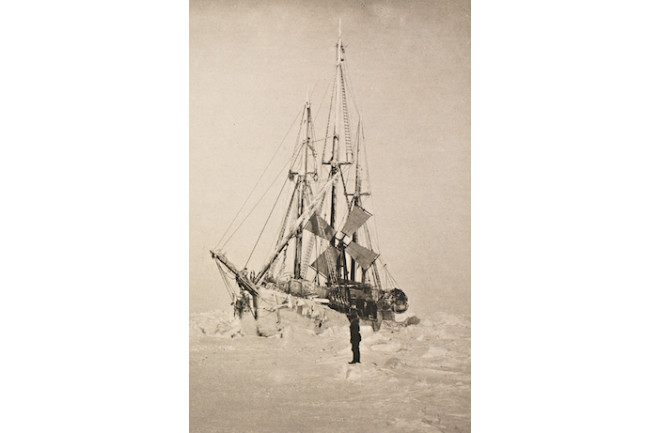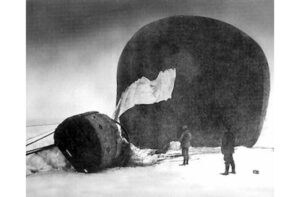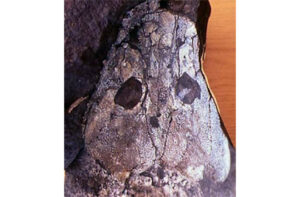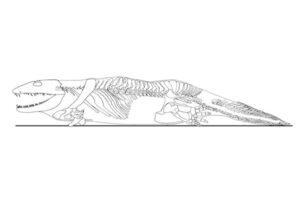
In 1893, the Norwegian zoologist Fridtjof Nansen set off to find the North Pole. He would not use pack dogs to cross the Arctic Ice. Instead, he locked his fate into the ice itself. He sailed his ship The Fram directly into the congealing autumn Arctic, until it became locked in the frozen sea. Nansen was convinced that the ice itself would drift up to the pole, taking him and his crew along for the ride.
For two and a half years they drifted with the pack. It gradually became clear to Nansen that The Fram had stopped moving north and was now traveling east instead, back towards Europe. He leaped out of the ship and tried to sled up to the pole, only to discover that the ice he was now traveling on was moving south. Only four degrees away from true north, he decided to retreat. He bolted back for Franz Josef Land.
The Fram meanwhile continued to drift east. After several months, it broke free of the ice, and the crew sailed the ship south to the island of Spitzbergen. There on the bare flats they saw a giant balloon.
Its pilot was a young Swedish engineer named Salamon André. André had decided that ships like the Fram could never reach the Pole, and that flight offered the only hope. He had convinced the king of Sweden and Alfred Nobel to pay for a balloon which he had brought by ship to Spitzbergen. And there he mixed tons of sulfuric acid and zinc to create hydrogen gas, which filled his silk canopy for four days. But gales hit the island before he was ready to launch the balloon, and then the Fram arrived with stories of how Nansen was racing on sleds towards the pole. André let the canopy fall back to the ground.
When he got back to Sweden, André discovered that Nansen had actually failed and had returned to Norway. He began to plot a second attempt. He returned to Spitzbergen in 1897 and this time he succeeded in launching his balloon. For a few days André floated north with his crew of two, bobbing up and down with the sudden changes in temperature and moisture of the Arctic atmosphere. But as he crossed over the edge of the polar ice, the voyage took a turn for the worse. The balloon became burdened with rain and snow, until the guidelines dragged across the ice, until the gondola bounced like a ball on the ground, until the balloon came to a rest.

For a week the crew huddled in cramped fog. André decided to pack sledges with food and a collapsible boat, which they dragged over the drifting ice. Hauling them across sloshing leads, they hoped, like Nansen, that they could find refuge in Franz Josef Land. But the ice wandered in the wrong direction under their feet, and after two months of this polar treadmill they reached a little hump of Arctic rock called White Island. In 1930 whalers came to the island and discovered their decrepit boat, their journals, and André’s corpse still sitting in the snow.
But in 1897, no one knew where André had gone. His fellow Swedish scientists searched for him by ship in the following summers, first travelling around Spitzbergen, and then heading to Greenland. As the pack ice opened, they traveled for eight weeks along its eastern edge in their sail- and steam-powered ship. They mapped the tentacled coast, and in one fjord along an elephant-backed mountain they named Celsius Berg, the explorers found bones.
They weren’t the bones of André and his crew. They were the bones of fish that had been resting in the Greenland rocks for over 350 millions years.
Other fossils of these fish had been found elsewhere in late Devonian rocks, but to those who studied that era, Greenland was a revelation. It was as if a new continent suddenly appeared on the map: other Devonian rocks were hid for the most part under a woody, bushy carpet in places like England and Pennsylvania, while the mountains of Greenland were mercilessly bare. Unfortunately the new fossils were also so remote that only some greater pretext–like the search for a famous explorer–could get the paleontologists to this far corner of the Arctic.
Another rationale came about thirty years later, when Denmark and Norway began competing in the late 1920s for control of Eastern Greenland, and the oil and minerals that it might hold. The Danes brought Swedish scientists with them, and they found bones of more fish, including lobe-fins, as well as a few things they didn’t know what to make of, simply marking them as “scales of a fish-like vertebrate of uncertain affinities.”
These expeditions were a bit less brutal than André’s and Nansen’s trips. The scientists still traveled in wooden steamers with three square-rigged masts, and while they could now bring a hydroplane for their surveys they still wore polar bear suits when they flew. In 1931 an energetic 22-year old geologist named Gunnar Säve-Söderbergh was put in charge of the expeditions. For sixteen hours a day he could climb mountains, throwing rocks into his rucksack and sketching out stratigraphy along the way.
He had a book of numbered tags made for the expeditions, P. for fishes, and A. for amphibians–a supremely confident system, considering that no one had ever found a Devonian amphibian. The fossil record of land vertebrates with legs–known as tetrapods–only went back about 300 million years and stopped cold.
That first summer, Säve-Söderbergh made his way around the northern slope of Celsius Berg and found more fish. In the cones of fallen rocks below the mountain’s eastern plateau, he also found more than a dozen scraps of a flat skull that didn’t look like any species of fish he had seen before. Optimistically, he marked them with A. tags.

Back in Stockholm that fall, Säve-Söderbergh slowly worked the bones free of the hard sandstone, painting them with alchohol and balsam to reveal the sutures between the bones. Looking down on the flat roof of the skull, he could see that some of the bones were patterned like the skulls of a group of fish known as lobe-fins–represented today only by lungfishes and coelacanths. Many naturalists argued that tetrapods had evolved from a lobe-fin ancestor. But Säve-Söderbergh could also see that it had some traits–like a long snout–that had only been found in early tetrapod fossils.
Looking at that skull, Säve-Söderbergh realized that he had found the earliest tetrapod. He named it Ichthyostega–“fish plate”–after the top of the animal’s skull.
The discovery was a great hit in Denmark, not only with the politicians who wanted to tighten their grip on Greenland, but with the public as well. In celebration one newspaper cartoonist drew a trout with dog legs carrying a pipe-smoking caveman, as snakes encircled mountain peaks and elephants flapped their wings overhead.
Säve-Söderbergh spent the following few summers mapping more of the region by foot, boat, and Icelandic horse. Fossils practically fell out of the rocks for him–mostly fish but on rare occasion another piece of Ichthyostega. The strange scales that had been found in 1929 turned out to be Ichthyostega’s ribs, massive and overlapping like Venetian blinds of bone. His assistants, particularly a student from the University of Upssala named Erik Jarvik, found more Ichthyostega skulls. One skull, unearthed in 1934, was so handsome the paleontologists brought it back across the Atlantic resting on a blue velvet pillow.
After five years Säve-Söderbergh was appointed a professor at the University of Uppsala, but in that year he was diagnosed with tuberculosis. He lingered in bed, managing to write a few papers about some of the fish he had collected, and died in June 1948 at only 40. The summer of Säve-Söderbergh’s death, the expedition to Greenland finally found the legs and shoulders and tail of Ichthyostega. At last it had most of a body.
In the 64 years since Säve-Söderbergh’s death, scientists have discovered many more early tetrapods and their extinct lobe-fin relatives. They’ve found some of these beasts on return trips to Greenland. But they’ve also found other species in places like Pennsylvania, northern Canada, Latvia, and, most recently, Nevada. Together, these fossils now offer an illuminating look at one of the most crucial transitions in the history of life. Without it, we’d still be fish in the sea.

Despite all the new company Ichthyostega has enjoyed lavish attention ever since its discovery, thanks to the quality and quantity of the fossils it left behind. For decades, Erik Jarvik pored over the fossils, and then, after his death, Jennifer Clack of the University of Cambridge and other paleontologists took a look for themselves.
Ichthyostega’s legs, while short and squat, had the elbows, knees, ankles, wrists, and toes that qualified it as a tetrapod. (Strangely, it had seven digits on its feet.) Its spine was sturdy, its hips and shoulders massive, its skull rigid. Yet Ichthyostega’s rigid skull still shared some traits with the flexible skull of lobe fins. It had a distinctive suture in the skull at the same place where a lobe-fin skull has a hinge. Under the tetrapod palimpsest its ancestry could be seen.
Ichthyostega’s tail was a similar mix of tetrapod and fish. Tetrapods have simple tails consisting of a long series of tapering vertebrae encased in flesh (ours has dwindled to a mere sprout, the coccyx). A lobe-fin’s tail, the motor that the animal uses to move through water, is a much more elaborate affair. Each vertebra has two long rods, one on top and one below. Attaching to each of these rods are more slender bones, called radials, and attaching to the radials is a wide fan of fin rays: a completely differerent kind of bone called dermal bone that also makes up scales. This complex anatomy allows a fish to set up waves in its tail either forward or backwards, to let it dart through the water or suddenly brake.
The bottom of Ichthyostega’s tail had a simplified tetrapod form, but the top still retained all the geegaws of a fish. It was, in a sense, still half in the water.

Clack and her colleagues have used the anatomy of Ichthyostega to figure out what it did in life–and, by extension, to get some clues to how the tetrapod body plan evolved. Long before Ichthyostega came on the scene, lobe-fins were already evolving some of the crucial pieces of that body plan–legs and wrists, for example. These ancient relatives lived unquestionably like fish, using gills to breath and depending on water to support much of their weight. It’s clear, in other words, that even though the tetrapod body is very good for getting around on land, it didn’t start evolving on land.
How far had things gotten by the time Ichthyostega showed up 360 million years ago? Clack has found that Ichthyostega’s ear was tuned for hearing underwater. But when she and her colleagues looked at a series of Ichthyostega skeletons, going from young to old, they found a different story. As the animals matured, their shoulders changed shape, providing more space for anchoring arm muscles. It’s possible that they spent a lot of time in the water when they were young and then spent more time on land when they became adults.
In 2005 Clack and her colleagues did a thorough study of Ichthyostega’s trunk–its spine and rib cage. They concluded that the tetrapod was weirdly stiff, unable to bend from side to side. They suggested two possible ways for Ichthyostega to get around on land. It might walk, but without bending its body the way, for examplpe, a salamander does. Or it might mimic an inchworm. It would bend its spine upwards, reach forward with its front legs, and then straighten out, pushing forward with its hind legs.
Today in Nature, Clack offers more clues to this puzzling creature. She collaborated with John Hutchinson of the Royal Veterinary College, an expert on biomechanics, and his postdoctoral researcher Stephanie Pierce. They have brought Ichthyostega back to life through a detailed computer reconstruction.
They started by making high-resolution scans of its fossils, which they then assembled into a virtual skeleton. Hutchinson has, over the past decade, figured out a way to estimate how animals moved based on this kind of reconstruction. By placing virtual muscles on the virtual bones, he can estimate their range of motion. Hutchinson knows his models are reliable, because he can test them on living animals. His estimates for the movements of animals such as otters and alligators are close to how they really move.
Here are a couple videos showing their results. I’ll explain them below.
The whole body:
The hind leg in action:
Simply put, Ichthyostega could not have been very impressive on land. No matter how hard it tried, it could not walk with its back legs. The limbs could move forward and back, but they could not swivel into a position that would allow Ichthyostega to plant its feet on the ground. Its forelimbs were a little more useful. It could bend its elbows. But its shoulders had little range of motion.
Combined with their rigid trunk, these new findings lead Clack and her colleagues to conclude that the best living analogy for Ichthyostega is a mudskipper. Mudskippers are not lobe-fins. Instead, they are ray-finnsed fish, more closely related to goldfish or trout. In an independent transition from the ocean, they evolved the ability to move around on land by crutching along on their front pair of fins. As the delightful video below from David Attenborough shows, mudskippers are quite successful in their peculiar ecological niche, crawling on muddy beaches, sucking up food from the muck, and then swimming through their underwater burrows to care for their young. But they are hardly an inspiring vision of tetrapods emerging on land.
Clack’s new study stands in intriguing contrast to one that I blogged about in December. University of Chicago scientists reported then that lungfish–our closest living aquatic relatives–can walk underwater with their pelvic fins–which correspond to the hind legs of tetrapods. The Chicago team argued that hind-leg-driven walking could have started out long before the tetrapod body evolved. Clack and her colleagues, on the other hand, propose that hind legs came late to the terrestrial party.
But if there’s one thing that the past couple decades of fossil-hunting has made clear is that the origin of tetrapods was not some linear march of progress. Starting about 380 million years ago, some lobe fins independently evolved tetrapod-like traits in a grand, unplanned experiment. Different species ended up with different combinations of those traits, perhaps adapting them to different ways of getting around underwater or on land. Ichthyostega might be a good model for the ancestor of all living tetrapods. Or it may have been a very weird beachcomber with hind legs that were only good as underwater paddles. To find out, scientists need to build more virtual skeletons of early tetrapods. And they need to head out to find more fossils.
Let’s just hope that they don’t have to follow doomed explorers to find them.
For more information about the discovery of tetrapod evolution, see my book At the Water’s Edge, from which parts of this post were adapted.
http://www.youtube.com/watch?v=KurTiX4FDuQ
[Images: skeleton from Clack’s site. Skull from Tree of Life. Images of the Fram and the failed balloon from Wikipedia.]
Originally published May 23, 2012. Copyright 2012 Carl Zimmer.